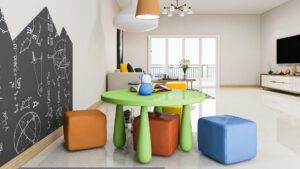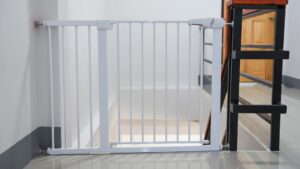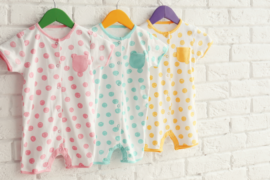As parents, our top priority is to keep our children safe and secure, especially within the confines of our own homes. Creating a safe home environment for your little ones involves more than just baby-proofing; it is about fostering a space where they can explore, learn, and grow without unnecessary risks. In this blog, we will provide comprehensive tips and expert advice on creating a safe and nurturing home for your children, from infancy through their early years.
Creating a Safe Home Environment for Your Little Ones
Understanding the Importance of a Safe Home Environment
Reducing Risks

A safe home environment minimizes the risk of accidents and injuries. Young children are naturally curious and may not understand the dangers that everyday household items can pose. By taking proactive steps to childproof your home, you can significantly reduce the likelihood of common accidents such as falls, burns, and poisoning.
Promoting Healthy Development

Safety is crucial for healthy development. When children feel safe, they are more likely to explore their surroundings, which is essential for cognitive and motor skill development. A secure environment allows children to play and learn with confidence, promoting overall well-being.
Essential Childproofing Tips
Secure Furniture and Appliances

Unsecured furniture and appliances can tip over, posing a significant hazard to young children. Anchor bookshelves, dressers, and televisions to the wall using safety straps or brackets.
Tips:
- Use furniture anchors or brackets specifically designed for heavy items.
- Place heavier items on lower shelves to reduce the risk of tipping.
- Keep remote controls, toys, and other enticing items out of reach on top of furniture.
Install Safety Gates

Safety gates are essential for preventing falls down stairs and restricting access to hazardous areas like the kitchen or bathroom.
Tips:
- Choose safety gates that are certified by safety standards organizations.
- Install gates at the top and bottom of stairs.
- Ensure the gate is securely mounted and cannot be easily dislodged by your child.
Cover Electrical Outlets

Electrical outlets are fascinating to young children but can be very dangerous. Use outlet covers to prevent little fingers from exploring them.
Tips:
- Use outlet covers that cannot be easily removed by children.
- Consider sliding outlet covers that automatically close when not in use.
- Keep electrical cords out of reach and securely fastened to the wall.
Kitchen Safety
Prevent Burns and Scalds

The kitchen is full of potential hazards, especially for curious toddlers. Take steps to prevent burns and scalds from hot surfaces and liquids.
Tips:
- Turn pot handles toward the back of the stove.
- Use back burners whenever possible.
- Keep hot drinks and food away from the edge of counters and tables.
Store Sharp Objects Safely

Sharp objects like knives, scissors, and kitchen tools should be stored out of reach or in childproof drawers.
Tips:
- Use childproof locks on drawers and cabinets containing sharp objects.
- Store knives in a high, secure place or use a knife block.
- Keep appliances with sharp blades, like blenders, unplugged and out of reach.
Bathroom Safety
Prevent Drowning

Even a small amount of water can pose a drowning risk to young children. Never leave your child unattended in the bath, even for a moment.
Tips:
- Always supervise your child during bath time.
- Use a non-slip mat in the tub to prevent falls.
- Empty the tub immediately after use.
Store Medications and Cleaning Supplies Safely

Medications and cleaning supplies should be stored in locked cabinets to prevent accidental ingestion.
Tips:
- Use childproof locks on cabinets containing medications and cleaning products.
- Store medications in their original containers with child-resistant caps.
- Keep the Poison Control Centre’s number handy: 1-800-222-1222.
Bedroom Safety
Ensure Safe Sleep Environments

Creating a safe sleep environment is crucial for your child’s well-being. Follow safe sleep guidelines to reduce the risk of sudden infant death syndrome (SIDS).
Tips:
- Place your baby on their back to sleep in a crib with a firm mattress and fitted sheet.
- Keep the crib free of pillows, blankets, and stuffed animals.
- Use a sleep sack instead of loose blankets to keep your baby warm.
Anchor Heavy Furniture

Just as in other parts of the home, heavy furniture in the bedroom should be anchored to the wall to prevent tipping.
Tips:
- Secure dressers, bookshelves, and other heavy furniture to the wall.
- Keep toys and other items that children might climb on out of reach on top of furniture.
- Use drawer stops to prevent drawers from being pulled out completely.
Living Room Safety
Secure Windows and Blinds

Windows and blinds can pose various hazards, from falls to strangulation risks with blind cords.
Tips:
- Install window guards or stops to prevent windows from opening more than a few inches.
- Use cordless blinds or secure cords out of reach with cord cleats.
- Move furniture away from windows to prevent climbing.
Cover Sharp Edges
Sharp edges on furniture can cause injuries if a child falls or bumps into them. Use corner and edge guards to cushion these areas.
Tips:
- Install corner guards on coffee tables, TV stands, and other furniture with sharp edges.
- Choose furniture with rounded edges when possible.
- Regularly check and replace guards as needed to ensure they remain secure.
Outdoor Safety
Secure Play Areas

Outdoor play is essential for children’s development, but it is important to ensure the play area is safe.
Tips:
- Inspect playground equipment regularly for wear and tear.
- Use soft, impact-absorbing materials like mulch or rubber mats under play structures.
- Ensure fences and gates are secure to prevent your child from wandering off.
Pool Safety

If you have a pool, taking proper safety measures is crucial to prevent accidents.
Tips:
- Install a fence around the pool with a self-closing, self-latching gate.
- Always supervise your child when they are near the pool.
- Teach your child water safety rules and consider enrolling them in swimming lessons.
Conclusion
Creating a safe home environment for your little ones is an ongoing process that requires vigilance and proactive measures. By taking steps to childproof your home, you provide a secure space where your child can explore, learn, and grow. Remember, safety is about balance—allowing your child the freedom to develop independence while minimizing unnecessary risks. With these tips and expert advice, you can create a home that nurtures your child’s curiosity and development while keeping them safe and sound.






